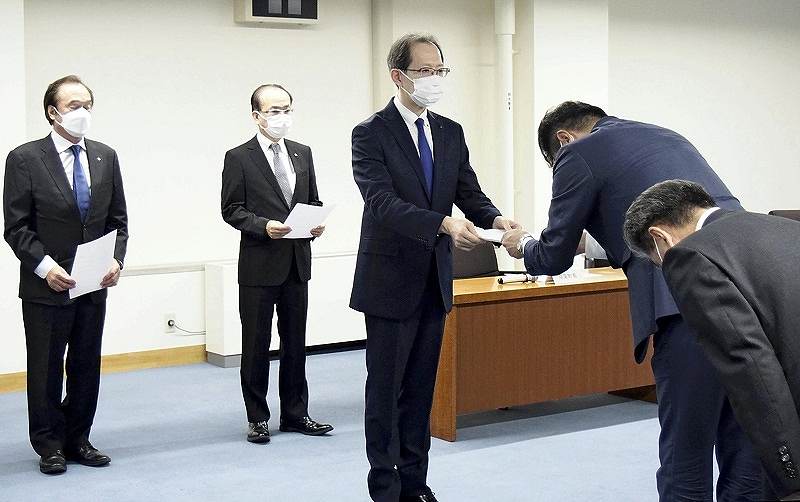Fukushima local govts approve treated water discharge facilities

Fukushima Gov. Masao Uchibori, third from left, hands TEPCO President Tomoaki Kobayakawa a document at the prefectural government office in Fukushima on Tuesday.
15:47 JST, August 3, 2022
The Fukushima prefectural government and two towns where the Fukushima No. 1 nuclear power plant is located have approved the construction of facilities needed to discharge treated water into the Pacific Ocean, clearing the way for this work to begin.
The prefectural government and the municipal governments of Futaba and Okuma conveyed their approval to Tokyo Electric Power Company Holdings, Inc., which is in charge of the plant, on Tuesday. This completes the procedures required to start construction. The focus will now shift to whether local fisheries operators will support the plan.
TEPCO could start construction of these facilities, including an undersea tunnel that will extend about 1 kilometer offshore from the plant, as soon as Thursday. TEPCO plans to start releasing treated water through the tunnel next spring.
Fukushima Gov. Masao Uchibori, Futaba Mayor Shiro Izawa and Okuma Mayor Jun Yoshida met with TEPCO President Tomoaki Kobayakawa at the prefectural government office, and each handed Kobayakawa a written document confirming approval of the construction work.
Water that became contaminated while cooling nuclear fuel that melted and rehardened in the 2011 accident triggered by the Great East Japan Earthquake has been treated to remove most of the radioactive materials except tritium. About 1.31 million tons of this treated water is stored in more than 1,000 tanks on the plant’s premises, which is hindering decommissioning work.
The written documents also demanded that TEPCO reliably implement safety measures required by the three local governments and other entities, such as the thorough maintenance and management of the discharge facilities, and take additional steps to reduce the volume of newly contaminated water.
Before being discharged into the ocean, the water will be diluted with seawater to reduce the concentration of tritium to one-fortieth or less of government-set discharge standards and about one-seventh of the World Health Organization’s standard for drinking water.
However, fishery operators remain firmly opposed to the plan due to concerns that harmful rumors about the discharged water could negatively affect their business. Uchibori called on TEPCO to boost efforts to foster greater understanding of and support for the discharge plan.
“As things stand, I can’t say that the plan has gained sufficient support from the residents of Fukushima Prefecture and the wider public,” Uchibori said.




